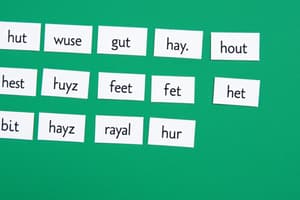Podcast
Questions and Answers
Which of the following is a diphthong?
Which of the following is a diphthong?
- /i:/
- /ɛ/
- /u:/
- /aɪ/ (correct)
Front vowels are produced with the body of the tongue positioned towards the back of the mouth.
Front vowels are produced with the body of the tongue positioned towards the back of the mouth.
False (B)
What symbol in the IPA represents the open-mid front unrounded vowel?
What symbol in the IPA represents the open-mid front unrounded vowel?
/ɛ/
A vowel sound that is produced with rounded lips is known as a ______ vowel.
A vowel sound that is produced with rounded lips is known as a ______ vowel.
Match the vowel classifications with their definitions:
Match the vowel classifications with their definitions:
Which of these is an example of a tense vowel?
Which of these is an example of a tense vowel?
Reduced vowels only occur in stressed syllables.
Reduced vowels only occur in stressed syllables.
Name one feature that distinguishes back vowels from front vowels.
Name one feature that distinguishes back vowels from front vowels.
The symbol /u:/ represents a ______ vowel sound.
The symbol /u:/ represents a ______ vowel sound.
In the vowel quadrilateral, which area signifies high front vowels?
In the vowel quadrilateral, which area signifies high front vowels?
Flashcards are hidden until you start studying
Study Notes
Vowel Classification
- Monophthongs: Single vowel sounds that remain the same throughout their pronunciation (e.g., /i:/ in "see").
- Diphthongs: Complex vowel sounds that begin with one vowel and glide into another within the same syllable (e.g., /aɪ/ in "my").
- Tripthongs: Combination of three vowel sounds in a single syllable (e.g., /aʊə/ in "fire").
- Front Vowels: Produced with the body of the tongue positioned forward in the mouth (e.g., /i:/, /ɛ/).
- Back Vowels: Produced with the body of the tongue positioned towards the back (e.g., /u:/, /ɔ:/).
- Central Vowels: Produced with the tongue positioned halfway between the front and back of the mouth (e.g., /ʌ/, /ə/).
Vowel Pronunciation
- Tension: Vowels can be categorized as tense (more muscular tension, e.g., /eɪ/) or lax (less tension, e.g., /ɪ/).
- Length: Vowel sounds can vary in duration; long vowels are typically held longer than short vowels.
- Open and Close: Vowels can be described as open (more space in the mouth, e.g., /æ/) or closed (less space, e.g., /i:/).
- Roundedness: Some vowels are produced with rounded lips (e.g., /u:/), while others are unrounded (e.g., /i:/).
Vowel Sounds In Phonetics
- IPA Symbols: The International Phonetic Alphabet (IPA) provides symbols to represent vowel sounds accurately (e.g., /i/, /e/, /æ/, /ɑ/, /ɔ/, /u/).
- Vowel Quadrilateral: A visual representation of vowel sounds based on tongue position and lip rounding, showing where vowels are articulated.
- Nasal Vowels: Produced with the airflow through the nose (common in some languages like French, e.g., /ɑ̃/).
- Reduced Vowels: Often occur in unstressed syllables, typically represented by the schwa sound /ə/.
This structure provides a clear overview of the essential aspects of vowels, aiding in understanding their classification, pronunciation, and phonetic representation.
Vowel Classification
- Monophthongs: Defined as single, unchanging vowel sounds during pronunciation. Example: /i:/ in "see."
- Diphthongs: Complex vowel sounds transitioning between two different vowels within a syllable. Example: /aɪ/ in "my."
- Tripthongs: Consist of three vowel sounds articulated in a single syllable. Example: /aʊə/ in "fire."
- Front Vowels: Created with the tongue positioned towards the front of the mouth. Examples include /i:/ and /ɛ/.
- Back Vowels: Formed with the tongue placed towards the back of the mouth. Examples include /u:/ and /ɔ:/.
- Central Vowels: Produced with the tongue in a neutral position between front and back. Examples include /ʌ/ and /ə/.
Vowel Pronunciation
- Tension: Vowels categorized as either tense (involving greater muscular tension, e.g., /eɪ/) or lax (involving less muscular tension, e.g., /ɪ/).
- Length: Vowel sounds can differ in duration, with long vowels held longer than short vowels.
- Open and Close: Open vowels have more oral cavity space (e.g., /æ/), while closed vowels have less (e.g., /i:/).
- Roundedness: Some vowels involve rounded lips during articulation (e.g., /u:/), whereas others, like /i:/, are unrounded.
Vowel Sounds In Phonetics
- IPA Symbols: The International Phonetic Alphabet uses specific symbols to accurately depict vowel sounds. Examples include /i/, /e/, /æ/, /ɑ/, /ɔ/, and /u/.
- Vowel Quadrilateral: A diagram illustrating the articulation of vowel sounds based on tongue position and lip rounding, aiding visualization of vowel relationships.
- Nasal Vowels: Vowels produced with airflow through the nasal cavity, prevalent in languages such as French. Example: /ɑ̃/.
- Reduced Vowels: Typically found in unstressed syllables; often represented by the schwa sound /ə/, indicating a less distinct vowel quality.
Studying That Suits You
Use AI to generate personalized quizzes and flashcards to suit your learning preferences.



